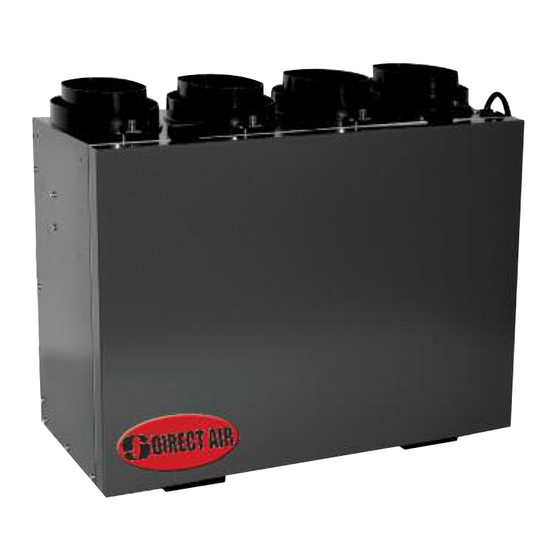Direct Air PHRVR96 Manuale di installazione, funzionamento e manutenzione - Pagina 7
Sfoglia online o scarica il pdf Manuale di installazione, funzionamento e manutenzione per Ventilazione Direct Air PHRVR96. Direct Air PHRVR96 16. Heat recovery ventilator

INSTALLING DUCTS TO / FROM INSIDE
To maximize airflow in the ductwork system, all ducts should be kept short and have as few bends or elbows as possible. Forty-five degree are preferred to 90º
elbows. Use "Y" tees instead of 90º elbows whenever possible.
All duct joints must be fastened with screws or duct sealant and wrapped with a quality tape to prevent leakage. Aluminum foil duct tape is recommended.
Galvanized ducting from the HRV/ERV to the living areas in the house is recommended whenever possible, although flexible duct can be used in moderation when
necessary.
Warning: The PHRV96 should be installed with a 4" (100mm) duct system that has less than 80 ft (25m) of equivalent duct length on the supply and on the
exhaust side. If longer runs are required, increasing the duct diameter or following the instructions below might help.
It is the responsibility of the installer to ensure all ductwork is sized and installed as designed to ensure the system will perform as intended. All air movement
devices have a performance curve. The amount of air (CFM) that an HRV will deliver is directly related to the total external static pressure (E.S.P.) of the sys-
tem. Static pressure is a measure of resistance imposed on the blower by length of duct work/number of fittings used in duct work, duct heater etc.
SUPPLY AIR DUCTING
In homes without a forced air furnace, fresh air should be supplied to all habitable rooms including, bedrooms and living areas. It should be supplied from high
wall or ceiling locations. Grilles that diffuse the air comfortably such as Fantech Contour Grilles are recommended.To avoid possible noise transfer through the
ductwork system, a short length (approximately 12", 300 mm) of nonmetallic flexible insulated duct should be connected between the HRV and the supply/exhaust
ductwork system.
If the floor is the only option available, then special care should be taken in locating grilles. Areas such as under baseboard heaters will help to temper the air.
Also optional inline duct heaters are available for mounting in the supply duct work to add heat if required.In homes with a forced air furnace, you may want to
connect the HRV to the furnace ductwork (see information below).
PRACTICAL TIPS
• Building Codes and Combustion
Appliance Installation Codes do not
allow location of return air grilles or
any opening such as a "breathing tee"
in an enclosed room with spillage sus-
ceptible combustion appliances.
• The fresh air inlet from the HRV needs
to respect a minimum
distance from the furnace return drop
to ensure proper air mixing and tem-
perature at the furnace core. See fur-
nace manufacturer for appropriate
specifications.
Exhaust Air Ducting
The stale air exhaust system is used to draw air from the points in the house where the worst air quality problems
occur. Due to its lower capacity, the PHRV96 is designed to vent from a single source point only and to the bath-
room that is closest to the unit or directly out of the furnace return. Additional source points may be drained from if
designed properly or installed on a separate Fantech fan bath kit to ventilate additional areas. Fantech bath kits are
listed below and are ideal for both new construction and retro fit.
Fantech bathroom kits for supplemental exhaust:
• REG100 (L/FL)
100cfm per fan
• REG140
190cfm per fan
• DLX110
150cfm per fan
• DLX150 (L/FL)
230cfm per fan
• DLX200
360cfm per fan
7
